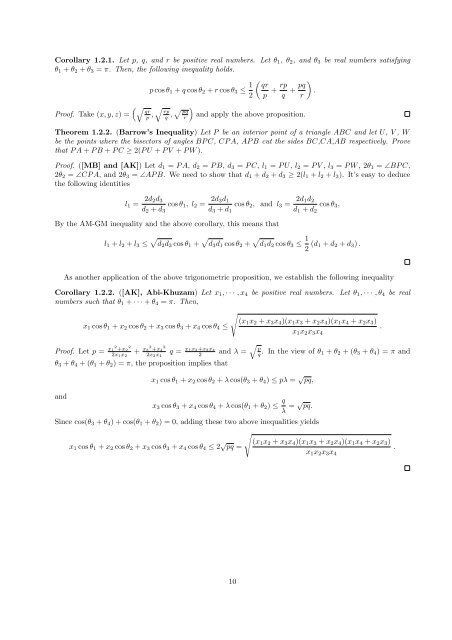Topics in Inequalities - Theorems and Techniques Hojoo ... - Index of
Topics in Inequalities - Theorems and Techniques Hojoo ... - Index of
Topics in Inequalities - Theorems and Techniques Hojoo ... - Index of
Create successful ePaper yourself
Turn your PDF publications into a flip-book with our unique Google optimized e-Paper software.
Corollary 1.2.1. Let p, q, <strong>and</strong> r be positive real numbers. Let θ 1 , θ 2 , <strong>and</strong> θ 3 be real numbers satisfy<strong>in</strong>g<br />
θ 1 + θ 2 + θ 3 = π. Then, the follow<strong>in</strong>g <strong>in</strong>equality holds.<br />
p cos θ 1 + q cos θ 2 + r cos θ 3 ≤ 1 ( qr<br />
2 p + rp<br />
q + pq )<br />
.<br />
r<br />
(√ √<br />
Pro<strong>of</strong>. Take (x, y, z) = qr<br />
p , rp<br />
q , √ )<br />
pq<br />
r<br />
<strong>and</strong> apply the above proposition.<br />
Theorem 1.2.2. (Barrow’s Inequality) Let P be an <strong>in</strong>terior po<strong>in</strong>t <strong>of</strong> a triangle ABC <strong>and</strong> let U, V , W<br />
be the po<strong>in</strong>ts where the bisectors <strong>of</strong> angles BP C, CP A, AP B cut the sides BC,CA,AB respectively. Prove<br />
that P A + P B + P C ≥ 2(P U + P V + P W ).<br />
Pro<strong>of</strong>. ([MB] <strong>and</strong> [AK]) Let d 1 = P A, d 2 = P B, d 3 = P C, l 1 = P U, l 2 = P V , l 3 = P W , 2θ 1 = ∠BP C,<br />
2θ 2 = ∠CP A, <strong>and</strong> 2θ 3 = ∠AP B. We need to show that d 1 + d 2 + d 3 ≥ 2(l 1 + l 2 + l 3 ). It’s easy to deduce<br />
the follow<strong>in</strong>g identities<br />
l 1 = 2d 2d 3<br />
d 2 + d 3<br />
cos θ 1 , l 2 = 2d 3d 1<br />
d 3 + d 1<br />
cos θ 2 , <strong>and</strong> l 3 = 2d 1d 2<br />
d 1 + d 2<br />
cos θ 3 ,<br />
By the AM-GM <strong>in</strong>equality <strong>and</strong> the above corollary, this means that<br />
l 1 + l 2 + l 3 ≤ √ d 2 d 3 cos θ 1 + √ d 3 d 1 cos θ 2 + √ d 1 d 2 cos θ 3 ≤ 1 2 (d 1 + d 2 + d 3 ) .<br />
As another application <strong>of</strong> the above trigonometric proposition, we establish the follow<strong>in</strong>g <strong>in</strong>equality<br />
Corollary 1.2.2. ([AK], Abi-Khuzam) Let x 1 , · · · , x 4 be positive real numbers. Let θ 1 , · · · , θ 4 be real<br />
numbers such that θ 1 + · · · + θ 4 = π. Then,<br />
√<br />
(x 1 x 2 + x 3 x 4 )(x 1 x 3 + x 2 x 4 )(x 1 x 4 + x 2 x 3 )<br />
x 1 cos θ 1 + x 2 cos θ 2 + x 3 cos θ 3 + x 4 cos θ 4 ≤<br />
.<br />
x 1 x 2 x 3 x 4<br />
√<br />
Pro<strong>of</strong>. Let p = x12 2<br />
+x 2<br />
2x 1 x 2<br />
+ x32 2<br />
+x 4<br />
2x 3 x 4<br />
q = x1x2+x3x4<br />
2<br />
<strong>and</strong> λ = p<br />
q . In the view <strong>of</strong> θ 1 + θ 2 + (θ 3 + θ 4 ) = π <strong>and</strong><br />
θ 3 + θ 4 + (θ 1 + θ 2 ) = π, the proposition implies that<br />
x 1 cos θ 1 + x 2 cos θ 2 + λ cos(θ 3 + θ 4 ) ≤ pλ = √ pq,<br />
<strong>and</strong><br />
x 3 cos θ 3 + x 4 cos θ 4 + λ cos(θ 1 + θ 2 ) ≤ q λ = √ pq.<br />
S<strong>in</strong>ce cos(θ 3 + θ 4 ) + cos(θ 1 + θ 2 ) = 0, add<strong>in</strong>g these two above <strong>in</strong>equalities yields<br />
√<br />
x 1 cos θ 1 + x 2 cos θ 2 + x 3 cos θ 3 + x 4 cos θ 4 ≤ 2 √ (x 1 x 2 + x 3 x 4 )(x 1 x 3 + x 2 x 4 )(x 1 x 4 + x 2 x 3 )<br />
pq =<br />
.<br />
x 1 x 2 x 3 x 4<br />
10

















